
In the modern digital age, artists are no longer confined to the walls of galleries and museums. With the rise of online platforms and social media, the art world has expanded, offering immense opportunities for artists to build and grow their brands. A strong brand distinguishes artists in a saturated market and connects them emotionally with their audience, potentially increasing their reach and revenue. Here’s a guide to developing a powerful brand to help artists thrive in today’s competitive landscape.
Understand Your Unique Value Proposition
The first step in building a brand is understanding what makes you unique. This involves a deep dive into your artistry to uncover the distinctive traits of your work. Are your creations bold and colorful, or do they have a minimalist aesthetic? Do you focus on particular themes or messages? Identifying what sets your art apart is crucial because it forms the foundation of your brand.
Define Your Target Audience
Knowing your audience is as important as understanding your art. Your target audience could range from art collectors and curators to the general public who appreciates your style. Consider factors such as age, income level, and interests. This demographic will influence how you market your art and where you promote it. Tailoring your brand’s messaging to resonate with this group increases the likelihood of engagement and sales.
Create a Consistent Visual Identity
A consistent visual identity is key to brand recognition. This includes your logo, color scheme, typography, and overall design aesthetics in your artwork, website, business cards, and social media profiles. Consistency ensures that your audience recognizes your brand across different platforms. An artist’s visual identity should reflect their work, creating a cohesive look and feel that enhances their brand.
Develop an Online Presence
In today’s digital world, an online presence is indispensable. A professional website acts as the central hub for your brand. It should showcase your portfolio, artist statement, biography, and contact information. Social media platforms like Instagram, Pinterest, and Facebook are crucial for artists looking to engage directly with their audience. Regular updates and interactions through these channels help maintain interest and build a community around your art.
Leverage Storytelling
Every piece of art has a story; sharing these stories can make your brand more relatable and engaging. Whether it’s the inspiration behind a particular work, the techniques used, or the challenges faced during its creation, storytelling adds depth to your brand. It allows your audience to form a personal connection with your art, making them more likely to support you.
Offer Exclusive Content
Providing exclusive content can greatly reward your followers and make them feel part of artistic journey. This might include behind-the-scenes videos, tutorials, early access to new works, or signed prints. Exclusive offers enhance customer loyalty and add value to your brand.
Engage with Your Community
Engagement goes beyond posting your work online. Responding to comments, participating in discussions, and collaborating with other artists are all part of building a community. This engagement shows that you value your audience’s support, encouraging a stronger connection to your brand. Additionally, attending art fairs, exhibitions, and networking events can expand your visibility and lead to potential collaborations and opportunities.
Protect Your Brand
As your brand grows, protecting your intellectual property becomes crucial. This may involve trademarking your brand name or copyrighting your artwork. Securing your brand’s legal aspects ensures that your creative assets are protected from misuse or infringement, giving you peace of mind and safeguarding your business.
Analyze and Adapt
Building a successful brand is an ongoing process that requires constant analysis and adaptation. Use tools like Google Analytics for your website or insights from social media platforms to track engagement and understand what works and what doesn’t. This data allows you to make informed decisions, helping you refine your strategies and better target your audience.
Stay True to Your Art
While building a brand involves considering market trends and audience preferences, remaining true to your artistic vision is important. The authenticity of your work is what will ultimately resonate with your audience. An artist’s brand should be a natural extension of their art, reflecting their values and vision.
By following these key steps, artists can develop a powerful brand that captures the essence of their work and connects deeply with their audience. A strong, authentic brand is the best beacon to survive and thrive in the vast sea of artists and creators.